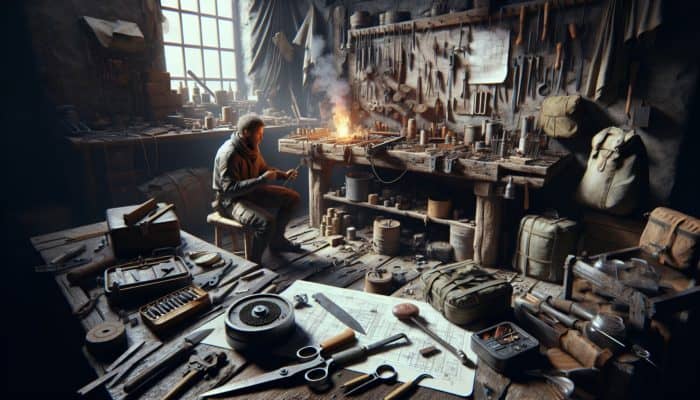Selecting Optimal Materials for Crafting
Recognising Valuable Natural Resources

DIY Survival Weapons: Identifying and recognising valuable natural resources is the first crucial step toward effectively constructing various diy survival weapons. Different environments, whether lush forests, rugged mountains, or arid deserts, offer a plethora of materials that can be creatively utilized. For instance, in a forest, resilient hardwood trees can yield robust timber suitable for crafting spear shafts or knife handles, while softer woods can be fashioned into arrows. In coastal regions, driftwood and seashells can be transformed into functional tools or parts for weapons. The ability to recognise these resources hinges on a comprehensive understanding of the ecosystem; for example, edible plants often thrive in proximity to viable crafting materials.
Searching the ground for stones can uncover sharp flint or obsidian, which are ideal for crafting blades. This skill is invaluable in survival situations, as many natural materials can be adapted into tools serving multiple purposes. Vines and resilient bark can be braided into cordage, a critical component for securely binding parts of your crafted weapons. This adaptability not only showcases your ingenuity but also ensures that you are maximising the potential of your environment, thereby significantly enhancing your chances of survival.
It is equally vital to comprehend the properties of each material you encounter. For example, while some woods are lightweight and easy to manipulate, others may offer greater durability, albeit at the cost of added weight. Striking a balance between these factors can help you determine which materials are best suited for the specific DIY survival weapons you plan to construct. Enhancing your proficiency in identifying and selecting these natural resources can substantially expand your survival toolkit.
Scavenging for Useful Man-made Items
Transforming everyday objects into functional survival tools is a crucial skill within the realm of diy survival weapons. Urban environments, often disregarded for their hidden potential, can serve as treasure troves of materials. Items such as plastic bottles, metal cans, and discarded furniture can be ingeniously repurposed into effective weapons or tools with a touch of creativity. For example, a robust plastic bottle can be cut and reshaped into a makeshift spear or a container for carrying water.
Diving into thrift stores, garage sales, or even rummaging through your own home can uncover valuable items, such as old bicycle parts, which can be adapted into slingshots or projectile launchers. Metal salvaged from obsolete appliances can be sharpened to create blades or arrow tips. The challenge lies in envisioning how these items can be effectively altered for practical use. Proficiency in welding or basic repair skills can further enhance your ability to craft sophisticated weapons from artificial materials.
Moreover, recognising the potential of these materials necessitates an understanding of their limitations. For instance, while reclaimed metal can be incredibly durable, it may require specific tools to shape and sharpen effectively. In this context, possessing knowledge about your available resources and the skills required to manipulate them is essential for creating effective diy survival weapons.
Assessing Material Durability for Optimal Performance
When constructing diy survival weapons, the durability of your selected materials is of paramount importance. A weapon’s efficacy is directly linked to its capacity to endure stress and wear during use. Each material possesses a unique lifespan and reacts differently to environmental conditions, which can significantly affect the weapon’s performance in survival scenarios. For instance, while hardwood is known for its durability, it may also splinter under extreme pressure, rendering it less reliable for long-term use.
Evaluating materials involves conducting tests whenever feasible. For instance, bending a branch or striking a stone can provide valuable insights into its strength and resilience. Wet or humid conditions can compromise the integrity of wood and certain metals, leading to issues such as rotting or corrosion over time. By understanding these factors, you can make informed decisions regarding which materials are best suited for crafting weapons that can withstand the challenges of survival situations.
Additionally, layering materials can significantly enhance durability. For instance, wrapping a wooden spear shaft in strong vines or leather can protect it from environmental elements while improving grip. This multi-material approach not only extends the lifespan of your diy survival weapons but also adds extra functionality, such as enhancing handling or providing camouflage in natural settings.
Constructing Essential Survival Tools

Creating a Basic Knife for Versatile Use
Crafting a basic knife is an essential skill that every survival enthusiast should master. The straightforward nature of knife-making ensures that you can create one with minimal resources, no matter what environment you find yourself in. Begin by selecting an appropriate piece of hard, sharp stone or metal. If you choose to work with stone, materials like flint or obsidian are ideal due to their capacity to be honed to a fine edge.
Please start the process by shaping the stone using another hard object to strike it, thereby forming a sharp blade. If metal is your medium of choice, old metal scraps sourced from appliances or tools can be effectively repurposed. You will also require a sturdy grip, which can be crafted from wood or even a thick piece of plastic. The handle must be comfortable to hold, as it will be frequently utilised during survival tasks like cutting, slicing, or digging.
Once you have fashioned both the blade and handle, secure the blade to the handle using strong cordage or adhesive. It is crucial to ensure that the fit is tight enough to withstand force without slipping loose. A well-crafted knife can serve as a versatile tool, suitable for food preparation, woodworking, and even self-defense, making it a fundamental addition to your DIY survival arsenal.
In practice, employing sharpening techniques will further enhance the knife’s effectiveness. Regularly honing your knife against a flat stone or utilising other natural abrasives will maintain its edge, ensuring that it remains a reliable tool within your survival toolkit. The ability to craft a knife not only equips you with a critical tool but also fosters confidence in your capacity to navigate challenging circumstances.
Building a Functional Slingshot
Creating a slingshot is an enjoyable and practical project that can significantly enhance your toolkit of diy survival weapons. This versatile weapon can be crafted using commonly found materials, such as a robust Y-shaped branch, durable rubber bands, and a small pouch made from fabric or leather. Please start by selecting a branch that fits comfortably in your hand, ensuring it possesses a strong and stable structure.
Once you have chosen the branch, cut it to your preferred length, typically around 10 to 12 inches. Smooth out any rough edges with a knife to ensure it is comfortable during use. The next step involves attaching the rubber bands, which should be sturdy enough to endure repeated use. The length of the bands will influence the range and power of your slingshot. Cut two equal lengths of rubber band and secure them to the upper forks of the Y-shaped branch using knots or adhesive, depending on your design preferences.
The pouch, which will hold the projectile, needs to be securely attached to the rubber bands, ensuring it is robust enough to accommodate various types of ammunition, including rocks and small metal balls. Test the slingshot with various projectiles to determine what works best for your needs. This process not only allows you to refine your crafting skills but also deepens your understanding of the mechanics involved in effectively launching projectiles.
Furthermore, enhancing your slingshot’s design can improve its overall effectiveness. Consider adding camouflage paint or natural material wraps to help it blend seamlessly with your environment. This attention to detail boosts your chances of successfully harvesting small game, making your slingshot an invaluable component of your survival strategy.
Assembling a Spear for Hunting and Defence

Creating a spear is an essential survival skill that can serve both hunting and self-defense purposes effectively. The key to a successful spear lies in the combination of a sturdy shaft and a sharp point. Begin by selecting a long, straight branch—ideally around 6-8 feet in length. The wood should be lightweight yet strong, with types such as ash or hickory offering excellent resilience.
The next step involves sharpening one end of the branch to create a point. This can be accomplished by whittling it down with a knife or striking it against a hard surface. If available, you can also affix a sharpened stone or metal tip to enhance the spear’s lethality. This attachment can be secured using cordage or resin for additional durability.
Once the spear is assembled, practising your throwing technique is crucial. The spear can be effectively utilised for fishing, hunting game, or as a defensive tool against potential threats. Understanding the physics of throwing will enable you to improve your accuracy and distance, making your spear a formidable diy survival weapon.
In varied environments, adapting your spear for specific conditions can further enhance its utility. For example, in marshy areas, a wider or broader tip may prevent it from sinking too deeply into the muck, allowing for effective fishing. Moreover, learning to camouflage your spear can provide a tactical advantage, keeping you hidden from prey while you hunt.
Maximising Weapon Effectiveness
Perfecting Sharpening Techniques for Optimal Performance
The effectiveness of any diy survival weapon heavily relies on the sharpness of its blade. Mastering various sharpening techniques is essential to ensure that your tools consistently perform at their best. A dull blade not only complicates tasks but also poses safety risks. Regular maintenance is crucial, and understanding different sharpening methods can empower you in the wild.
One widely used method involves utilising natural sharpening stones, such as whetstones or river rocks, which can be easily found in many environments. Start by wetting the stone to reduce friction. Then, hold the blade at a 20-degree angle against the stone and push it along the edge in a smooth, even motion. This technique can be repeated on both sides of the blade to create a fine edge.
Alternatively, employing simpler methods, such as honing the blade on a hard surface like concrete or flat rocks, can also prove effective. Though not as precise, these methods can be executed conveniently in a survival scenario, ensuring your weapon remains functional. Additionally, learning to identify the right materials for sharpening is crucial; some stones may wear down the blade more quickly than others.
Incorporating regular sharpening into your tool maintenance routine will not only enhance the performance of your diy survival weapons but also prolong their lifespan. Taking the time to refine your sharpening skills translates to better preparedness in survival situations. Always remember, a sharp weapon is not only safer to use, but it also increases your chances of success in critical tasks.
Enhancing Accuracy for Effective Use
Accuracy is paramount when using DIY survival weapons, especially in the context of hunting or self-defense. Without precision, the effectiveness of your crafted tools diminishes significantly. Improving accuracy often involves a combination of practice and technique adjustments tailored to your environment and the type of weapon being used.
For projectile weapons such as slingshots or spears, understanding the mechanics of motion is crucial. Experiment with various stances and grips to determine what feels most comfortable and stable. The placement of your feet, body alignment, and even breath control can all contribute to enhancing your overall performance. Regular practice in diverse scenarios will build muscle memory, allowing for more instinctive and accurate use of your weapons.
Additionally, employing visual markers can aid in aiming. When training, set up targets at varying distances to become accustomed to estimating range and adjusting your aim accordingly. Furthermore, understanding the ballistics of your weapon—how factors such as wind and humidity affect its trajectory—can also improve your precision. This knowledge will help you adapt your techniques and increase your success rate in real-world situations.
Incorporating visualization techniques can further enhance accuracy. Close your eyes and visualise the target, imagining the exact path your projectile will take. This mental practice can forge a stronger connection between your mind and body, leading to improved focus and execution when it counts most.
Implementing Creative Modifications for Versatility
Modifying your diy survival weapons can significantly boost their versatility and overall effectiveness. By incorporating creative alterations, you can adapt your weapons to suit specific tasks or environments. This level of customisation not only allows for a broader range of applications but also enhances your confidence in utilising these tools.
For example, adding a paracord handle to a knife can enhance grip and control, especially in wet or slippery conditions. If you’ve crafted a spear, consider attaching fishing line or a net to its tip for fishing expeditions. This modification transforms a simple weapon into a multi-functional tool capable of addressing various survival needs.
Another modification worth considering is the incorporation of camouflage elements. By painting your weapons with natural colors that blend into your environment or adding foliage for camouflage, you can enhance stealth during hunting or defensive maneuvers. Understanding your surroundings allows you to modify your weapons to maximise the element of surprise, giving you an edge in critical scenarios.
Experimenting with different materials and designs can yield innovative results. For instance, creating a multi-tool spear with detachable attachments can enable you to switch between hunting and fishing modes swiftly. Such adaptability proves invaluable in survival situations, where resourcefulness and creativity can mean the difference between success and failure.
Ensuring Safety and Ethical Practices
Practicing Safe Handling Procedures
Implementing safe handling procedures for diy survival weapons is essential to prevent accidents and injuries. Regardless of whether you are wielding a knife, spear, or slingshot, understanding safety protocols ensures that you can manage your tools effectively without compromising your well-being. The first principle of safety is awareness; always be conscious of your surroundings and the people nearby when handling weapons.
When using knives, it is crucial to cut away from your body and maintain a secure grip. This technique minimises the risk of accidental slips that could result in injury. For spears, ensure that you have a clear target and that your path is unobstructed before throwing. Establishing these habits early will help ingrain safety into your routine, making it second nature.
The storage of your diy survival weapons is another critical safety factor. Keep weapons securely stored and out of the reach of children or untrained individuals. Employ protective sheaths for knives and blades, and store spears upright or in designated areas where they won’t pose hazards. Additionally, consider using clear and accessible storage solutions that allow you to swiftly retrieve your weapons when necessary while keeping them safe from misuse.
Regularly inspect your weapons for signs of wear and tear. A cracked handle or dull blade can lead to accidents. By routinely maintaining your tools, you not only extend their lifespan but also ensure they remain safe to use. Remember that safety is an ongoing responsibility; the more vigilant you are, the more effectively you can prevent accidents and injuries.
Understanding Ethical Considerations in Weapon Use
Utilising diy survival weapons comes with a range of ethical considerations that should not be overlooked. Understanding the morality of crafting and utilising these weapons is essential for maintaining a respectful relationship with your environment and community. Ethical hunting practices, for example, dictate that you should only take what you need, allowing animal populations to thrive and ensuring ecological balance.
Before engaging in any hunting or self-defence activities, consider the implications of your actions. Are the local wildlife populations stable? Are you in an area where hunting is permitted? These questions are vital for ensuring that your use of survival weapons does not contribute to overhunting or disruption of ecosystems. Educating yourself on local laws and regulations is equally important, as many regions have specific guidelines governing the use of weapons.
Moreover, the potential for unintended harm to others must be critically assessed. Whether you are using a slingshot, spear, or knife, having a clear understanding of your responsibility in wielding these tools is paramount. Engaging in training or workshops on survival ethics can further enhance your understanding and commitment to responsible practices.
Ultimately, the ethical considerations surrounding diy survival weapons focus on respect for nature, wildlife, and fellow human beings. Strive to leave the environment untouched and utilise your skills in a manner that promotes sustainability and respect, ensuring that your survival efforts coexist harmoniously with the world around you.
Awareness of Legal Regulations
Navigating the legal landscape surrounding diy survival weapons is crucial for anyone interested in crafting and using these tools. Laws vary widely from region to region, and understanding your local regulations can help you avoid legal complications. In certain areas, specific types of weapons may be restricted or require permits for use, particularly in urban settings where safety concerns are heightened.
Researching local laws is the first step in ensuring compliance with relevant regulations. Many regions have specific criteria regarding blade lengths, types of weapons that can be carried, and the circumstances under which they can be used. Understanding these regulations not only protects you from potential legal issues but also reinforces your commitment to responsible weapon ownership.
In addition to weapon-specific laws, consider the implications of using your survival weapons in self-defence situations. While many places permit self-defense, there are often strict guidelines governing the use of force. It’s critical to understand what constitutes reasonable self-defence in your jurisdiction, as misuse of weapons in a defensive scenario could lead to severe legal consequences.
Being proactive about legal awareness demonstrates a commitment to responsible survival practices. Consider joining local survival groups or forums where you can discuss legal matters and share insights with others. This collaborative approach not only enhances your knowledge but also connects you with like-minded individuals who prioritise the safe and respectful use of diy survival weapons.
Training for Emergency Response Preparedness
In the realm of survival, possessing diy survival weapons necessitates a solid understanding of emergency response training. Accidents can happen, and knowing how to react effectively can save lives. Training in first aid and emergency medical response is vital for anyone crafting and using weapons, as it equips you with the necessary skills to address injuries that may occur during weapon use or in survival situations.
Consider enrolling in courses that offer training in first aid, CPR, and emergency management. These skills not only apply to your safety but also extend to helping others in need. Understanding how to treat wounds, perform resuscitation, and manage shock can be invaluable in survival contexts, especially when professional medical assistance is unavailable.
Additionally, integrating emergency drills into your routine can prepare you for unexpected situations. Simulating scenarios where you may need to use your diy survival weapons can help you practice your response in a controlled setting. This can include everything from practising self-defence techniques to honing your skills in using weapons for hunting or gathering food.
Establishing a comprehensive emergency response plan for yourself and your group is also crucial. Identify potential hazards in your environment and develop strategies to mitigate risks associated with weapon use. By being proactive, you create a safer atmosphere for yourself and those around you, ensuring that your survival preparations are sustainable and responsible.
Assessing Community Impact of Survival Practices
Evaluating the potential impact of using diy survival weapons on your community is a vital aspect of responsible survivalism. These weapons, while potentially life-saving, can also create fear or misunderstandings among neighbours. Understanding community dynamics and addressing concerns can contribute to a more harmonious coexistence with those around you.
Open communication is key. Engaging with your community about your intentions and practices regarding the use of weapons can demystify the subject and promote understanding. Hosting workshops or demonstrations on responsible weapon crafting and safety can also foster goodwill and encourage others to think critically about survival practices.
Moreover, consider the broader implications of weapon use in your community. Reflect on how your actions influence perceptions of survivalism and the impact on local wildlife. Ethical hunting practices should be a priority, ensuring that your efforts do not disrupt local ecosystems or contribute to negative narratives about survivalism.
Ultimately, community impact assessment involves striking a balance between individual survival preparedness and collective well-being. By fostering a culture of respect and understanding, you can ensure that your DIY survival practices not only serve your needs but also contribute positively to the community as a whole.
Continuous Training and Practice
Developing Essential Skills for Survival
Skill development is at the heart of effectively utilising diy survival weapons. Engaging in consistent practice not only enhances your proficiency but also boosts your confidence when using these tools in real-world situations. Establishing a training regimen tailored to your specific weapons and their applications is crucial for long-term success in survival scenarios.
Start by identifying the key skills required for each weapon in your arsenal. For instance, if you have crafted a knife, focus on techniques such as cutting, slicing, and whittling. Practising these techniques in various contexts will improve your dexterity and enhance your overall proficiency. Similarly, if you’ve created a slingshot or spear, dedicate time to refining your aim and throwing techniques in different environments.
Training doesn’t always have to be a solitary endeavour. Joining local survival groups or engaging in community workshops can provide valuable opportunities for shared learning. This collaborative approach allows you to learn from others’ experiences while also gaining diverse perspectives on survival techniques and weapon use. These interactions foster camaraderie and support within the survival community.
Additionally, recording your training progress can provide insight into your development over time. Keeping track of your proficiency and areas for improvement can enhance your motivation and commitment to mastering your skills. Setting personal goals and challenges can also keep your practice sessions engaging and dynamic, ensuring you continually seek to enhance your abilities with diy survival weapons.
Implementing Regular Maintenance for Longevity
Regular maintenance of your diy survival weapons is essential for ensuring their longevity and effectiveness. Just as you would care for any tool or equipment, your crafted weapons require attention and upkeep to perform optimally in critical situations. Establishing a maintenance routine can prevent deterioration and prolong the lifespan of your tools.
Incorporate sharpening sessions into your routine, particularly for knives and blades. Regularly honing the edge keeps your weapon ready for use, ensuring it performs well when needed most. Similarly, inspect wooden components for signs of wear, rot, or splintering. Addressing these issues promptly can prevent accidents and maintain the integrity of your weapons.
Cleaning your tools is equally important. Residue from food, dirt, or moisture can lead to rust or degradation over time. After each use, take the time to clean your weapons, ensuring they remain in top condition. Utilising natural cleaning methods, such as vinegar or baking soda, can be effective for maintaining different materials without introducing harmful chemicals.
Moreover, when storing your diy survival weapons, consider the environment. Humidity and temperature fluctuations can affect materials differently, so finding a suitable storage space is essential. Utilising protective sheaths and keeping weapons out of direct sunlight can minimise damage and maintain their functionality. By committing to regular maintenance, you safeguard your investment in survival preparedness and ensure your weapons remain reliable when you need them most.
Simulating Real-World Scenarios for Enhanced Preparedness
Practising with your diy survival weapons in simulated real-world scenarios significantly enhances your preparedness and confidence. Training in controlled environments allows you to experience the dynamics of using your weapons without the pressures of an actual survival situation. This approach not only builds muscle memory but also helps you develop strategies for various challenges you may face.
Create training exercises that mimic potential survival situations. For example, if you’ve crafted a spear, practice using it in various types of terrain, such as open fields, forests, or rocky environments. This versatility ensures you are comfortable adapting your techniques to varying conditions. Incorporating elements of stealth and camouflage during practice can further enhance your skills, making you a more effective hunter or defender.
Engaging with others during practice sessions can provide valuable feedback and insights. Setting up friendly competitions or challenges can also foster a sense of camaraderie while pushing you to improve. This collaborative approach allows you to share knowledge, techniques, and experiences, enriching your overall understanding of survival weaponry.
Moreover, documenting your practice sessions can help you track your progress and identify areas for improvement. Reflecting on your performance enables you to refine your techniques and adapt your training regimen accordingly. Simulating real scenarios not only hones your skills but also builds resilience, ensuring that you are mentally and physically prepared for whatever challenges may arise in actual survival situations.
Adapting to Varied Environments
Modifying Weapons for Weather Conditions
Adapting your diy survival weapons to function effectively in a variety of weather conditions is crucial for maximising their utility in diverse environments. Weather can significantly impact the performance of your crafted tools, from the materials used to the techniques employed. Understanding these variations allows you to prepare more adequately for unpredictable situations.
In wet or humid conditions, for instance, wooden weapons are prone to rotting or warping. To counteract this issue, consider applying natural oils or sealants that protect the wood from moisture. Additionally, opting for treated or synthetic materials where possible can enhance durability while reducing the risk of damage. When crafting weapons for rainy environments, focus on materials that can withstand exposure to water without compromising their strength.
Conversely, in dry conditions, specific modifications may be necessary. Dust and sand can wear down the sharpness of blades or interfere with the mechanisms of projectile weapons. Regular cleaning and maintenance become even more critical in these environments. Using protective covers for your diy survival weapons when not in use can also prevent damage from exposure to dust or abrasive elements.
Understanding how temperature affects materials is equally important. Cold conditions can cause some metals to become brittle, while extreme heat might warp plastics. Preparing your weapons for the specific challenges posed by the environment not only enhances their reliability but also increases your confidence in using them when it matters most. Adapting to weather conditions is a vital aspect of survival preparedness that can significantly enhance your effectiveness as a survivor.
Modifying Weapons for Various Terrain Types
Adapting your diy survival weapons for different terrain types is essential for ensuring their effectiveness in various environments. Each terrain presents unique challenges and opportunities, requiring modifications to your weapons and techniques to maximise their utility. Understanding these adaptations can enhance your chances of success in survival scenarios.
In forested areas, for instance, camouflage is critical. Modifying your weapons to blend with your surroundings can improve your stealth while hunting or foraging. Painting or wrapping your weapons with natural materials, such as leaves or bark, creates a less detectable profile. The design of your weapons may also need to be adjusted; shorter, more compact tools can be more manageable in dense brush.
When navigating rocky terrain or mountainous regions, consider the weight and durability of your crafted weapons. Spears with reinforced tips can be advantageous for both hunting and self-defence, while knives with sturdy handles are crucial for traversing rough surfaces. In these environments, the ability to seamlessly transition between different tasks—such as hunting, cutting, and climbing—becomes paramount, necessitating versatile weapon designs that allow for rapid adaptation.
In coastal or marshy terrain, modifying your fishing gear can prove beneficial. Attaching nets or hooks to your spears can enhance your ability to catch fish, while ensuring that your slingshot is adapted for launching heavier projectiles can improve effectiveness. Understanding how to modify your diy survival weapons for specific terrains not only enhances their value but also empowers you to thrive, regardless of the challenges posed by your environment.
Responding to Changes in the Environment
The ability to quickly adapt your survival strategies in response to environmental changes is crucial for the effective use of diy survival weapons. Natural environments are dynamic and can undergo significant changes due to weather conditions, seasonal fluctuations, or other external factors. Staying attuned to these changes allows you to modify your tactics and maintain your preparedness.
For example, seasonal variations can affect animal behaviour and food availability. During the migration of specific species, adjusting your hunting strategies to align with their movements can yield better results. Understanding how different weather conditions impact wildlife can inform your approach to using your weapons effectively.
Moreover, being aware of changes to your surroundings, such as terrain alterations due to erosion or natural disasters, can influence your weapon choice and usage. For instance, after heavy rains or flooding, waterways may swell, leading to different fishing opportunities. Adapting your strategies to capitalize on these situations can significantly enhance your chances of success in survival scenarios.
Regularly assessing your environment and being proactive in adjusting your diy survival weapons usage is key to maintaining resilience in the face of change. Developing situational awareness and honing your ability to adapt will not only improve your survival skills but also foster a deeper connection with the natural world. Ultimately, being responsive to environmental changes ensures that you remain well-prepared for whatever challenges may arise.
Exploring Advanced Techniques
Crafting Complex and Versatile Weapons
Crafting complex diy survival weapons requires advanced skills and a deep understanding of materials and techniques. As you progress from basic tools to more intricate designs, the potential for versatility and effectiveness increases significantly. Engaging in this level of crafting enhances your survival toolkit, allowing for a broader range of applications.
Begin by experimenting with composite materials. For instance, combining wood and metal can create a robust spear or a multi-functional knife that serves various purposes. Understanding the properties of each material allows you to refine your designs to maximise performance. Advanced techniques may also involve layering different types of wood, which can enhance strength and durability while providing a lightweight solution.
Moreover, incorporating mechanisms into your weapons can elevate their functionality. Creating a bow with adjustable draw weights, for example, allows for adaptability based on your needs, whether hunting large game or small animals. Understanding the mechanics of your crafted tools opens up a realm of possibilities, including adding features like detachable tips or interchangeable components for various uses.
Engaging in workshops or collaborating with experienced crafters can accelerate your learning process. Sharing techniques and insights not only enhances your skill set but also fosters a sense of community among survivalists. Exploring advanced crafting techniques equips you with the knowledge and expertise to create sophisticated diy survival weapons that can significantly improve your chances of survival in challenging situations.
Utilising Unconventional Materials for Innovation
The use of unconventional materials in crafting diy survival weapons can yield unique and effective tools that enhance your survival capabilities. Thinking outside the box expands your creative potential, allowing you to repurpose items that may otherwise be discarded. This not only promotes resourcefulness but also empowers you to adapt to your environment in innovative ways.
For instance, items like bicycle tires or rubber bands can be repurposed to create powerful slingshots or elastic launchers. Old electronics may provide wiring, casings, or even battery components for crafting unique devices, such as traps or signalling tools. Understanding the properties of these materials is crucial; some plastics may be more durable or flexible than others, which in turn influences their suitability for specific weapon designs.
In addition to repurposing materials, consider combining multiple unconventional items to create hybrid tools. For example, using an old frying pan as a shield or a metal lid for deflecting projectiles can offer unique advantages in defensive situations. Another example involves utilising natural resources, such as bamboo, which can be shaped into lightweight yet sturdy weapons or tools.
Exploiting unconventional materials encourages creativity and adaptability, which are essential traits for survivalists. Exploring the possibilities that arise from these materials can lead to the development of innovative diy survival weapons that effectively meet your needs, regardless of your surroundings.
Mastering the Art of Survival Weaponry
Developing a comprehensive understanding of survival weaponry is crucial for increasing your chances of survival in any situation. Mastering the intricacies of different weapons, their applications, and the techniques necessary for their effective use can mean the difference between success and failure. This mastery is not only about crafting but also about the psychological aspects of using these tools confidently.
Begin by immersing yourself in various weapon types, understanding their strengths and weaknesses. Engaging with experienced practitioners, whether through workshops, online communities, or hands-on training, can provide invaluable insights and help refine your skill set. Observing others can reveal techniques and approaches you may not have considered, enhancing your overall proficiency.
Furthermore, regularly practising with your diy survival weapons in diverse scenarios can deepen your understanding. Simulating realistic situations allows you to explore the nuances of using your weapons effectively. This practice not only builds muscle memory but also helps you develop the mental fortitude necessary to remain calm in high-pressure situations.
In addition to practical skills, honing your mental preparedness is vital. Understanding the mindset required for survival—resilience, adaptability, and resourcefulness—will empower you to face challenges head-on. By mastering the art of survival weaponry, you equip yourself with the confidence and knowledge necessary to navigate even the most challenging situations with skill and poise.
Enhancing Durability for Long-Lasting Effectiveness
Ensuring the durability of your diy survival weapons is paramount for long-term effectiveness. Crafting weapons that can withstand the rigours of use in various environments requires careful consideration of materials and techniques. By incorporating durability-enhancing strategies, you can significantly extend the lifespan and functionality of your crafted tools.
Begin by selecting high-quality materials renowned for their strength and resilience. When crafting wooden weapons, choose hardwoods that can withstand pressure and resist wear. For metal components, opt for corrosion-resistant options, such as stainless steel, to ensure longevity even in harsh conditions. Understanding the properties of different materials will guide your choices as you build your arsenal.
In addition to material selection, reinforcing vulnerable points on your weapons can enhance durability. For example, wrapping handles with durable cordage or tape can provide additional grip while protecting the structure from damage. For blades, consider applying a protective coating or sealant to prevent rust and degradation.
Conduct regular inspections of your DIY survival weapons to identify areas that need attention. Addressing wear and tear promptly ensures that your tools remain reliable and in good working condition. Cultivating a mindset of proactive maintenance not only increases weapon durability but also fosters a deeper appreciation for the craftsmanship involved in creating these essential survival tools.
Frequently Asked Questions (FAQs)
What constitutes diy survival weapons?
Diy survival weapons are tools crafted from both natural and artificial materials, designed for self-defence, hunting, or other survival scenarios. They can encompass a variety of items, from knives and spears to slingshots and more complex creations, allowing individuals to adapt to different environments effectively.
Which materials are suitable for crafting diy survival weapons?
Common materials include wood, stone, metal scraps, and even everyday items such as plastic or rubber. The selection often depends on the resources available in your environment and the specific weapon being crafted.
How can I ensure my diy survival weapon is durable?
To enhance durability, select high-quality materials, reinforce vulnerable areas, and conduct regular maintenance. Applying protective coatings, utilising sturdy bindings, and inspecting for wear can prolong the lifespan of your weapon.
Are there ethical considerations when using diy survival weapons?
Yes, ethical hunting practices and respect for local wildlife are crucial. Ensure you understand local regulations and prioritize the sustainable use of resources to minimize negative impacts on ecosystems.
What steps can I take to improve my accuracy with a slingshot or spear?
Improving accuracy involves practice, understanding mechanics, and refining your stance and grip. Regularly training with various distances and conditions can build muscle memory and enhance your precision.
What safety measures should I take when using diy survival weapons?
Always be aware of your surroundings, handle weapons with care, store them securely, and conduct regular inspections to ensure their safe storage. Practicing safe techniques and ensuring proper storage can minimise the risk of accidents.
Can I utilise unconventional materials for crafting weapons?
Absolutely. Unconventional materials, such as bicycle tires, plastics, or discarded items, can be effectively repurposed into survival weapons. Creativity and resourcefulness are key in adapting these materials for practical use.
How often should I practise with my diy survival weapons?
Regular practice is essential for maintaining proficiency. Incorporate training sessions into your routine, simulating various scenarios to enhance your skills and build confidence.
What actions should I take if my weapon breaks or becomes unusable?
If a weapon becomes unusable, assess the damage and consider repair options or repurposing materials for new tools. Always have backup plans and additional materials on hand for crafting replacements.
Are there specific training programmes for survival with diy weapons?
Yes, many survival schools and outdoor programmes offer training in crafting and using diy survival weapons. Joining local survival groups or online forums can also provide valuable resources and insights for enhancing your skills.
Explore our world on X!
Surviving Without Fuel: Essential Strategies
Exploring the Fundamentals of Fuel-Free Living What Is the Concept of Living Without Fuel? Surviving Without Fuel: The concept of living without fuel centers on the pivotal goal of significantly reducing or entirely eliminating our dependence on conventional energy sources, such as gasoline and diesel. This lifestyle choice underscores the importance of adopting sustainable alternatives […]
Grid-Down Survival: Essential Strategies for Resilience
Effective Strategies for Preparing for Grid-Down Scenarios Building a Comprehensive Stockpile of Essential Supplies Grid-Down Survival: To thrive during a grid-down scenario, building a comprehensive stockpile of essential supplies is crucial for your survival and that of your family during prolonged power outages. The strategy involves gathering a diverse assortment of items that meet fundamental needs such […]
Prepper Relocation Guide: Universal Strategies
Crucial Factors to Consider When Relocating for Preparedness Key Influences on Relocation Choices Prepper Relocation Guide: When contemplating a relocation for preparedness, it is essential to conduct a detailed assessment of various personal and situational elements. One of the primary considerations is to evaluate individual needs and preferences. These can encompass factors such as family […]
Prepper Community Tips: Essential Strategies for Preparedness
Establishing a Resilient Prepper Network for Effective Collaboration How Can You Evaluate the Trustworthiness of Potential Prepper Allies? Prepper Community Tips: Establishing a network of trustworthy preppers is paramount for building a reliable community. The cornerstone of any robust prepper group is trust, which is nurtured through consistent actions and demonstrated levels of preparedness. Engaging […]








Your exploration of material selection in crafting DIY survival weapons truly highlights the symbiotic relationship between our environment and our resourcefulness. It’s fascinating to think about how different ecosystems not only provide us with the raw materials we need but also teach us something about adaptation and survival techniques.
This exploration of natural resources and their potential applications in crafting survival weapons raises a fascinating point about our evolving relationship with nature. While the focus here is on utilitarian crafting, we must also consider the cultural implications of utilizing these resources. For instance, many indigenous cultures have longstanding traditions of weapon crafting that tie into their spiritual beliefs and ecological stewardship. This context intertwines with the skills you’ve mentioned, as recognizing which materials to use is not just about survival—it’s also about respect for the environment.